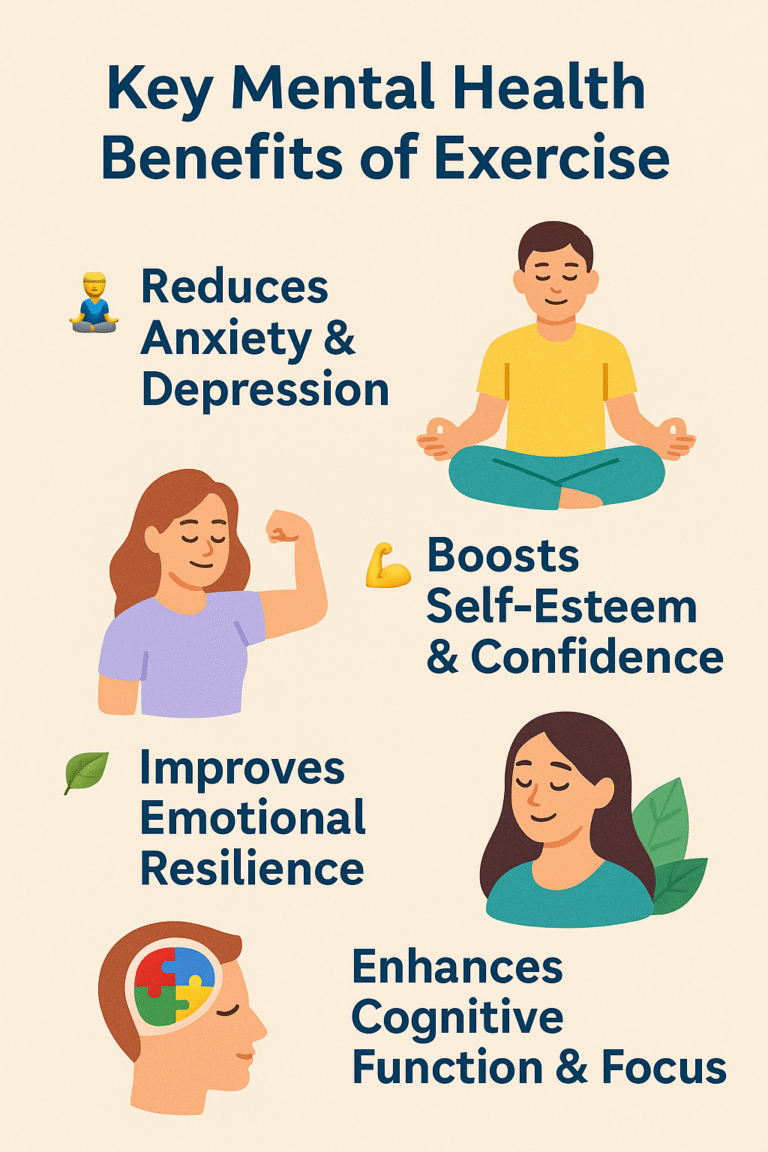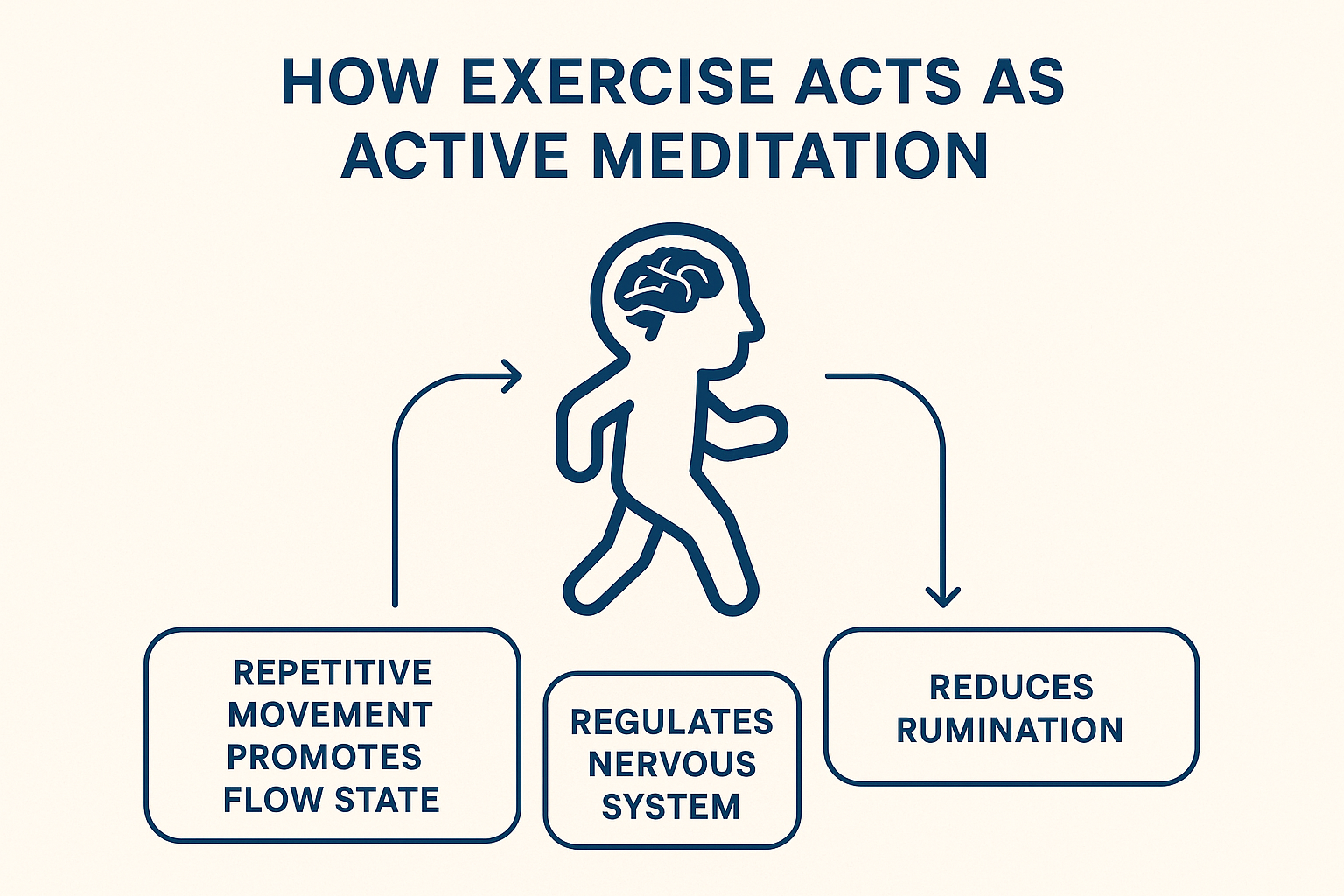How Exercise Improves Mental Health: A Science-Backed Guide
In this article, we explore how exercise improves mental health, and why even a small dose of movement can make a big difference. While most of us know that staying active benefits the body, fewer people realize just how powerful regular movement can be for the mind. From boosting mood and reducing anxiety to improving focus and emotional resilience, the mental benefits of exercise are backed by science and experienced daily by millions.
We’ll break down the latest research, share practical tips to help you integrate movement into your routine, and guide you on how to get started, no matter your fitness level. Whether you’re new to exercise or simply looking for extra motivation, understanding how exercise improves mental health might be the push you need to move your body and support your mind.
How Exercise Impacts The Brain
Hormones & Endorphins
Exercise can improve mental health as it triggers the release of endorphins, which can act as natural mood boosters and pain relievers. Moreover, exercising triggers a release of dopamine contributing to feelings of pleasure and motivation.
Interestingly, exercise can decrease cortisol levels over time. It is common for exercise, especially intense exercise to increase cortisol temporarily, however this is followed by a decrease when the body starts to recover. Regular, moderate-intensity exercise, however, can help regulate cortisol levels over time, potentially leading to lower baseline cortisol and better stress management.
Sleep Quality
Regular physical activity generally improves sleep quality by helping you fall asleep faster and spend more time in deeper sleep stages. Exercise can also decrease daytime sleepiness and reduce the need for sleep medication in some individuals.
A systematic review found that physical activity was positively associated with sleep quality among different categories of populations. This is consistent with the World Health Organization (WHO) and Centers for Disease Control and Prevention (CDC) recommending engaging in physical activities to improve sleep quality. The association between physical activity and sleep quality can be attributed to several mechanisms, including the release of endorphins, which can lower stress and anxiety, resulting in improved relaxation and better sleep, regulation of circadian rhythms, and a rise in body temperature followed by a subsequent decrease helping in initiating sleep [14,45]. Furthermore, exercise stimulates the release of neurotransmitters such as serotonin and norepinephrine, which are involved in mood regulation and relaxation, perhaps assisting in better sleep start and maintenance.
Enhances Neuroplasticity
Key Mental Health Benefits of Exercise
Before we explore the individual benefits, it’s worth appreciating just how powerful regular movement can be for your mind. Exercise isn’t just about building strength or burning calories—it’s a proven way to boost mood, sharpen focus, and build emotional resilience. The image below gives a quick snapshot of the key mental health benefits we’ll unpack in detail.
Reduces Anxiety & Depression
Exercise triggers the release of feel-good chemicals like endorphins and serotonin, which act as natural mood lifters. Over time, regular movement helps reduce symptoms of anxiety and depression, often as effectively as medication or therapy for mild to moderate cases.
Boosts Self-Esteem & Confidence
Sticking to a fitness routine builds more than muscle—it builds confidence. Whether it’s hitting a personal best or simply showing up, exercise reinforces a sense of achievement and self-worth, helping you feel stronger both physically and mentally.
.

Improves Emotional Resilience
Life throws curveballs, and exercise helps you catch them with grace. Physical activity trains your brain to cope with stress by lowering cortisol levels and giving you space to process emotions. The result? A calmer, more grounded you.
Enhances Cognitive Function & Focus
Movement sharpens your mind. Regular exercise improves memory, concentration, and mental clarity by boosting blood flow to the brain and stimulating the growth of new neural connections. It’s one of the simplest ways to upgrade your focus
Optimal Exercise Levels for Mental Wellbeing
When it comes to improving mental health, more isn’t always necessary. Research shows that even modest amounts of exercise, around 30 minutes of moderate activity, three to five times a week, can lead to noticeable improvements in mood, stress levels, and overall emotional wellbeing. Activities like brisk walking, cycling, swimming, or strength training are all effective, especially when done consistently. Importantly, benefits often begin to appear after just a few weeks of regular movement, and even shorter sessions (10–15 minutes) can offer immediate boosts in mood and focus. The key is finding a routine that’s realistic and enjoyable, something you’ll stick with not just for physical fitness, but for mental resilience too.
Real-Life Tips for consistency
Here are some helpful tips to help you stay consistent in your exercise endeavors:
- Stack it with daily habits (habit stacking)
- Use implementation intentions
- Make is enjoyable (dancing, walking with friends, sports)
- Keep it low-pressure
If you want to read more on how to use these techniques, here is an article which details everything you need to know about motivation and habits ->
The Psychology of Motivation: Why We Struggle to Stay Consistent
Movement as a Form of Active Meditation
A rarely discussed benefit of exercise on mental health is using movement as a form of active meditation. Exercise mimics the neurological effects of meditation, especially through activities like walking, lifting, or repetitive motion.

How Exercise Acts as Active Meditation
Repetitive movement like walking, running and lifting can induce a flow state, a mindful, present-focused awareness that reduces mental noise. These actives often create a rhythm in breathing and body, helping regulate the nervous system. This mirrors the effects of mindfulness meditation, where awareness increases while internal distractions fade. Crucially, these experiences suppress activity in the brain’s default mode network (DMN) — the region linked to self-referential thought, mind-wandering, and even self-criticism
Perfect for the Restless Mind
Traditional meditation can be daunting — especially for those who struggle to sit still or focus. But active meditation doesn’t require stillness. Instead, it transforms movement into mindfulness, offering the same cognitive benefits without the stillness of a cushion. This makes it an accessible, science-backed tool for reducing stress, anxiety, and overthinking — especially rumination, a major contributor to depression.
“This is where exercise and meditation overlap in surprising ways — a topic rarely explored when discussing how exercise improves mental health.”
If you’ve ever felt mentally clearer after a workout, now you know why.
Conclusion
In a world where mental health challenges are increasingly common, exercise offers a powerful, accessible, and evidence-based way to support emotional well-being. Whether it’s the mood-boosting endorphins, improved sleep, reduced stress, or the confidence that comes from setting and achieving physical goals—movement provides more than just physical benefits.
You don’t need to run marathons or spend hours in the gym. Even small, consistent steps—like a daily walk, lifting weights, or stretching—can create meaningful change over time. Ultimately, prioritizing movement isn’t just about looking better; it’s about feeling better, thinking clearer, and building a more resilient, balanced life.
1 thought on “How Exercise Improves Mental Health: A Science-Backed Guide”
Great breakdown! It’s wild how modding communities keep classics like Incredibox fresh. If you’re into music and creativity, check out Classroom 6x for some unique twists on the original.